Recently, several people suggested that in the past decades, it was a rare occurrence for anglers to catch a ray off the beach. The implication was that there was an increased abundance of rays nowadays which I found confusing, knowing the deteriorating state of biodiversity in our seas. So I contacted Declan Quigley, an independent researcher and a previous guest on episode 151, who has an unparalleled knowledge of historical records related to fish, fisheries and angling. I asked him the question: “Is it true that several decades ago, let’s say in the 50s or maybe 70s, it was a very rare occurrence for anglers to catch a ray off the beach?” His answer was so detailed and so factual that I couldn’t just let it stay in my inbox. So here it is in the form of a blog post.
There would appear to be very little published information about shore angling for ray in Irish waters between the 1940s and 1980s. Although ray were undoubtedly taken from the shore during this period, it seems that, in general, they were not specifically targeted. For a long time, it seems that bass and cod were the main species targeted by shore anglers, particularly during the summer and winter respectively. The following is a brief summary of the literature that I have to hand.
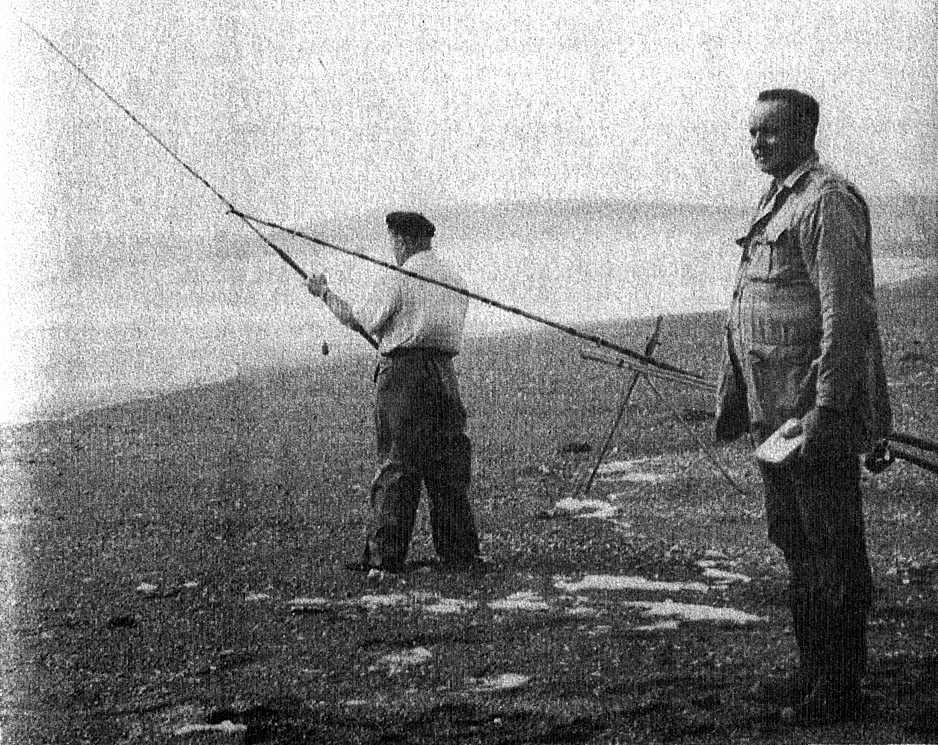
In 1948 (Anon, 1948) a number of places along the south coast between Kilmore Quay, Co Wexford and Valentia, Co Kerry were already noted as superb sea angling centres, albeit mostly from boats. It was noted that the west coast was more or less unexplored territory, but that there was every reason to expect that centres affording first-class fishing would be discovered on the coasts of Cos Galway, Mayo, Sligo and Donegal.
In 1953, W.E. Davies speculated about the largely untapped sea angling potential of the southern coast of Ireland where ‘fish of herculean proportions‘ undoubtedly awaited discovery, but made no mention of rays.
In 1956, Arthur Went collated details on some exceptionally large boat-caught skate captured between 1907 and 1928 off Ballycotton (Co Cork), Valentia (Co Kerry) and Letterfrack (Co Galway). However, here was no specific mention of rays
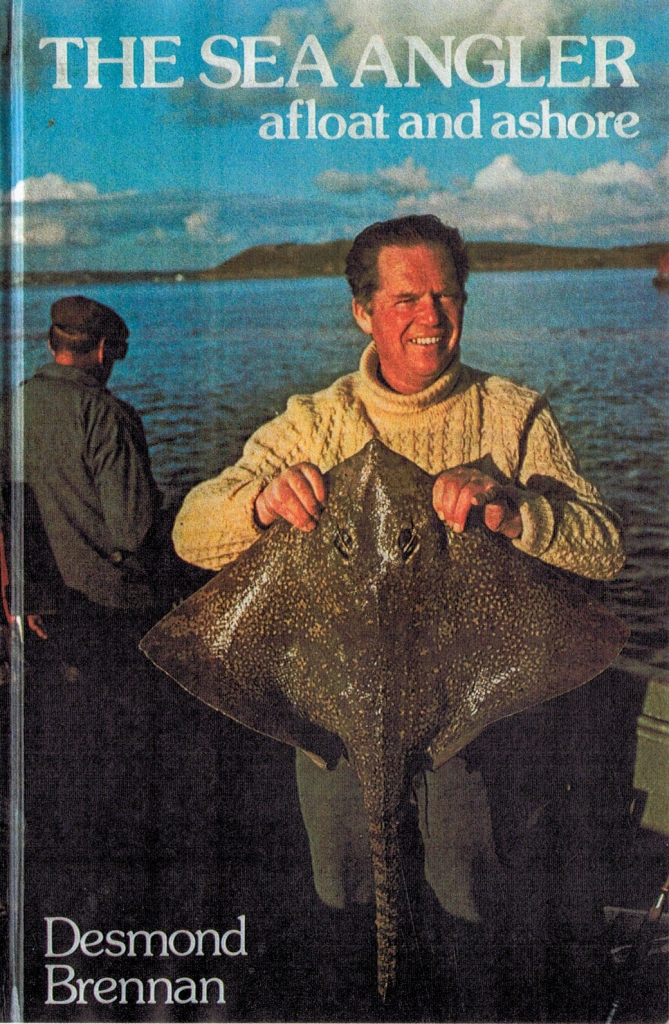
In 1956, Michael Kennedy wrote: ‘not so very long ago, the man who fished in the sea for sport used as a matter of course the gear and methods of the professional (commercial fisherman)… the amateur sea fisherman (angler) was usually a seaman first, and a fisherman (angler) only incidentally‘. However, Kennedy acknowledged that sea angling was becoming increasingly popular and devoted a specific chapter to surf fishing, but made no mention of rays.
In 1965, Des Brennan noted that there had been significant progress, not only in the numbers of sea anglers, but also in the development of new fishing tackle and techniques. He devoted a specific chapter to skates & rays, but only briefly alluded to the capture of Thornback Rays and Stingrays from the shore.
In 1966, Clive Gammon remarked: ‘Not until a very few years ago was any wide scale (sea) fishing done… Many Irish beaches have still to see a fishing rod‘. He specifically referred to surf-fishing for bass and tope, but made no mention of shore-caught rays.
In 1974, Des Brennan published the first book specifically devoted to angling for skates & rays in Irish waters. Although he remarked that some species of ray can be taken by shore anglers, and provided some specific guidance, he noted that most rays are taken from boats.
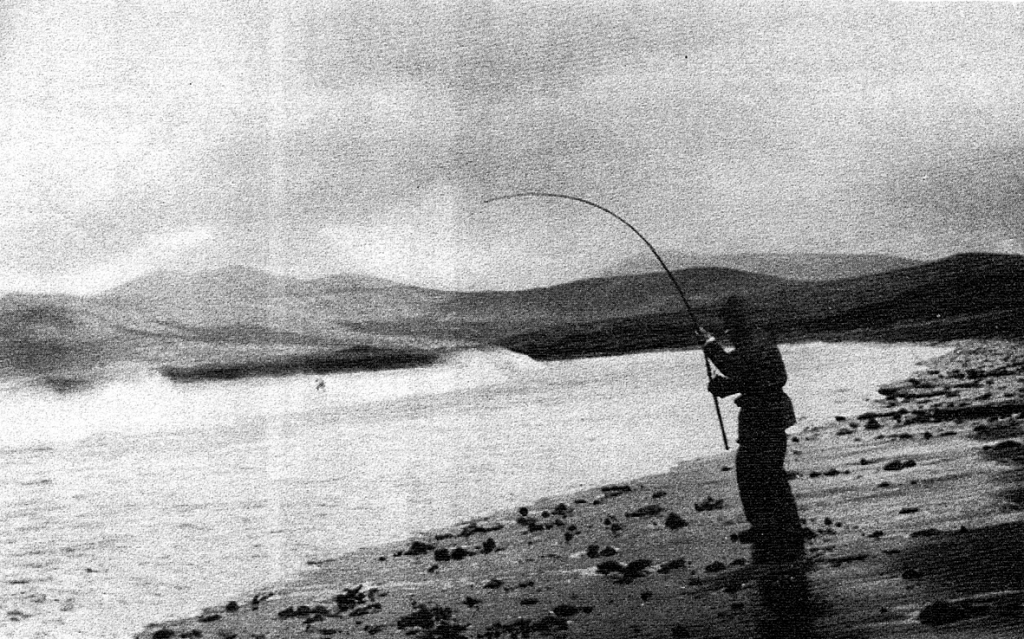
In 1980, Kevin Linnane (in Warner et al. 1980), noted that some species of rays can be taken from the shore, particularly Thornback Ray.
In 1989, Ken Whelan also noted that Thornback Rays (and Stingrays) can be taken from the shore, but did not mention anything about other species of rays.
In summary, I suspect that during the 1940-80s, shore-caught rays were probably rarely reported rather than rarely captured. It is possible that the results from shore-based angling competitions over a number of years in specific locations may provide useful background effort-related data (e.g. Tralee & Brandon Bays).
Irish Specimen Fish Committee (ISFC) data on rod-caught rays
In the absence of any specific historical data on shore-caught rays, I examined the ISFC data on specimen skates & rays (Table 1). I confined the analysis to rays because all of the larger species of skates are presumed to have been boat-caught.
There are a number of other important caveats in interpreting the ISFC ray data: it is not effort related, the distinction between boat and shore-caught specimens was only recorded over the last three years, in some cases the minimum specimen weights have varied over the years, and the recent introduction of length-based criteria.
| Common Name | Species | Year included by ISFC | Boat | Shore | Total number up to 2022 | Specimen Weight (kg) | Specimen TL (cm) | Record (kg) |
|---|---|---|---|---|---|---|---|---|
| Common Skate | Dipturus batis | 1956 | 647 | 0 | 647 | none | ≥180 | 100.33 |
| White Skate | Rostroraja alba | 1956 | 24 | 0 | 24 | none | ≥180 | 74.910 |
| Long-Nosed Skate | Dipturus oxyrinchus | 1956 | 0 | 0 | 0 | 36.287 | none | none |
| Electric Ray | Tetronarce nobiliana | 1978 | 3 | 1 | 4 | 9.072 | none | 40.000 |
| Undulate Ray | Raja undulata | 1969 | 0 | 412 ? | 412 | none | ≥85 | 8.172 |
| Blonde Ray | Raja brachyura | 1959 | 297 | 0 | 297 | 11.340 | ≥100 | 16.798 |
| Homelyn Ray | Raja montagui | 1969 | 255 | 11 | 266 | 2.268 | ≥65 | 3.759 |
| Painted Ray | Raja microocellata | 1970 | 0 | 230 | 230 | 4.536 | ≥80 | 7.813 |
| Thornback Ray | Raja clavata | 1956 | 130 | 1 | 131 | 7.000 | ≥100 | 16.798 |
| Sting Ray | Dasyatis pastinaca | 1959 | 0 | 90 ? | 90 | 13.000 | ≥90 | 33.200 |
| Cuckoo Ray | Leucoraja naevus | 1969 | 56 | 9 | 65 | 1.600 | ≥63 | 2.270 |
Advances in angling gear technology (e.g. beach-casting rods & reels), angler experience, angler behaviour (e.g. killing vs catch & release), the discovery of ‘new hot spots’, and the potential effects of commercial exploitation also need to be considered.
The effects of the ‘troubles’ in Northern Ireland (particularly from 1969 onwards) also adversely impacted the annual number of tourist anglers, particularly from the UK. It is important to note that some of the ray species were only included for the first time during 1969. Indeed, since the early 1970s, the contribution of tourist anglers has continued to decline, whereas the contribution of Irish anglers has continued to increase albeit there was an appreciable drop during the recent COVID pandemic.

Annual Numbers of Specimen Rays
Apart from Painted Rays and Stingrays, which have demonstrated a general upward trend over the years, all of the other ray species have demonstrated an appreciable, albeit fluctuating downward trends.
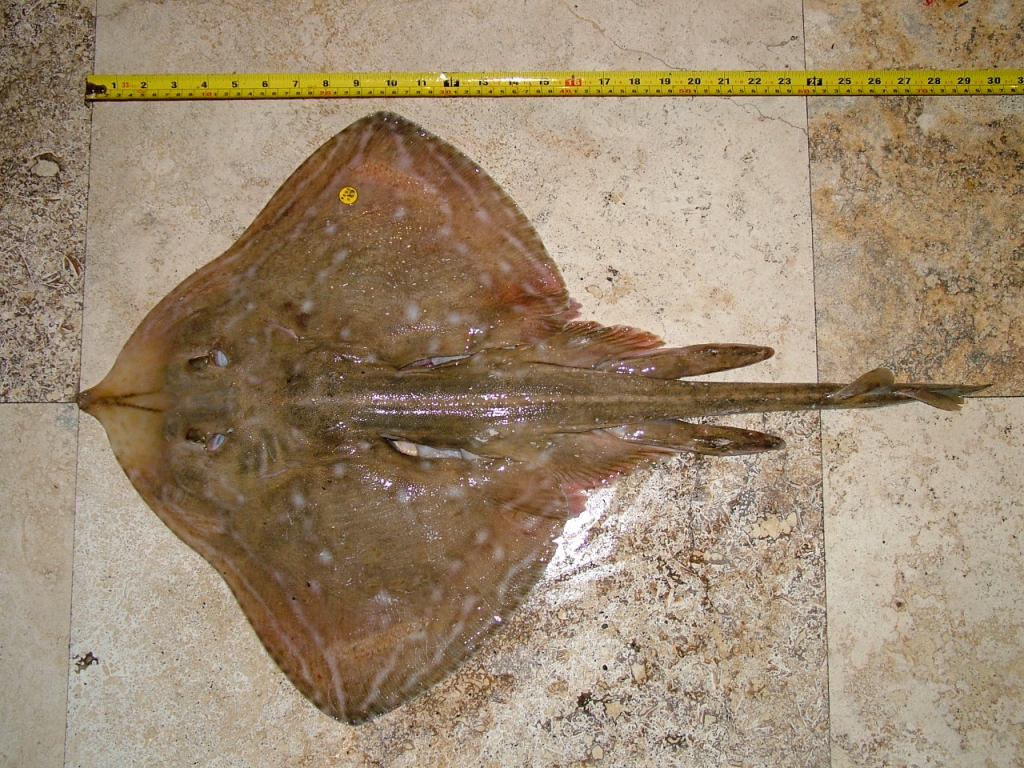
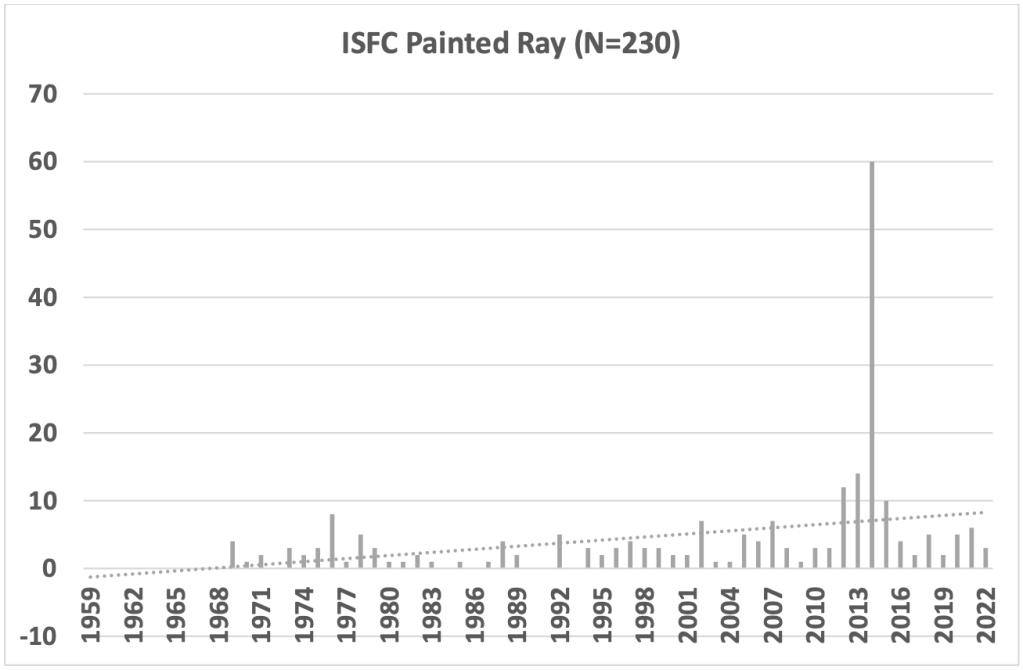
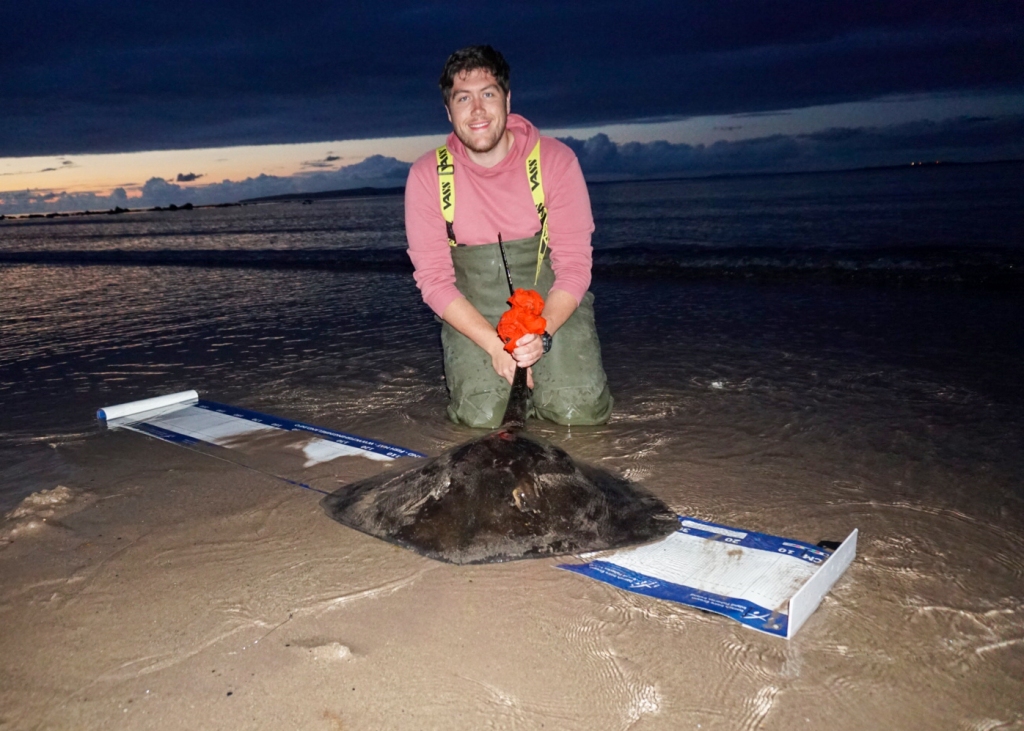
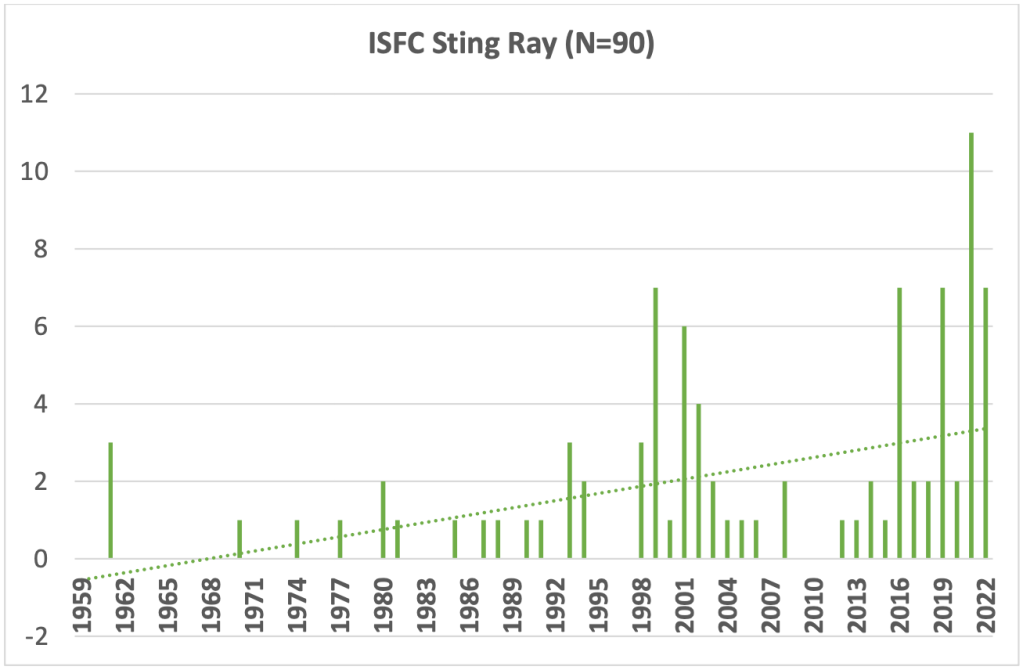
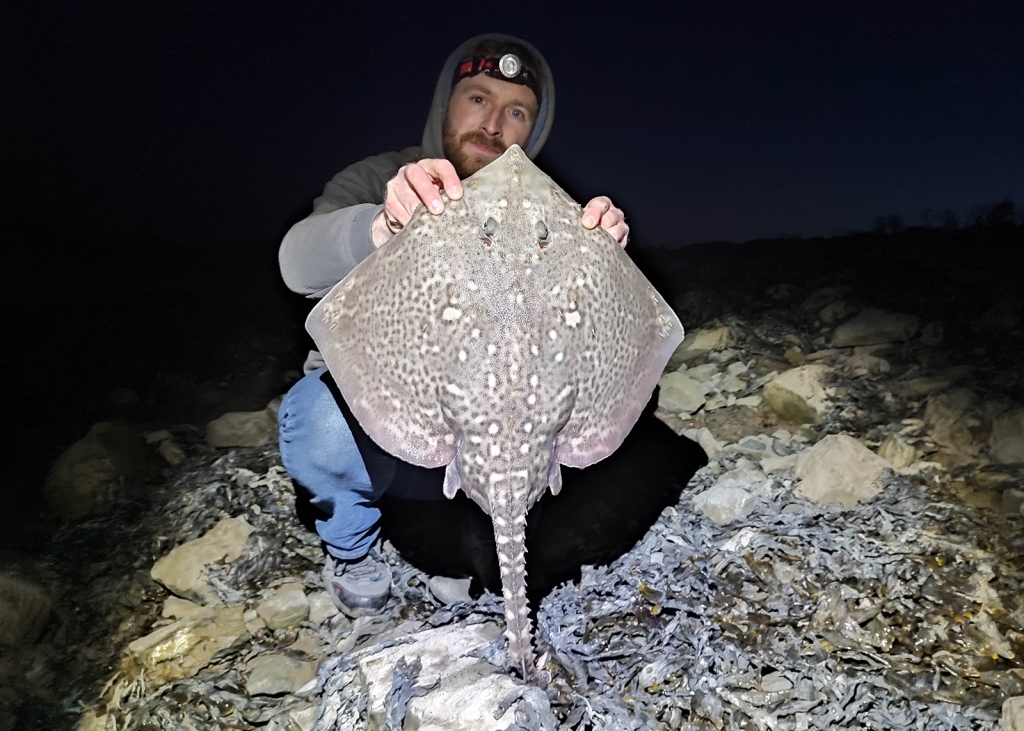
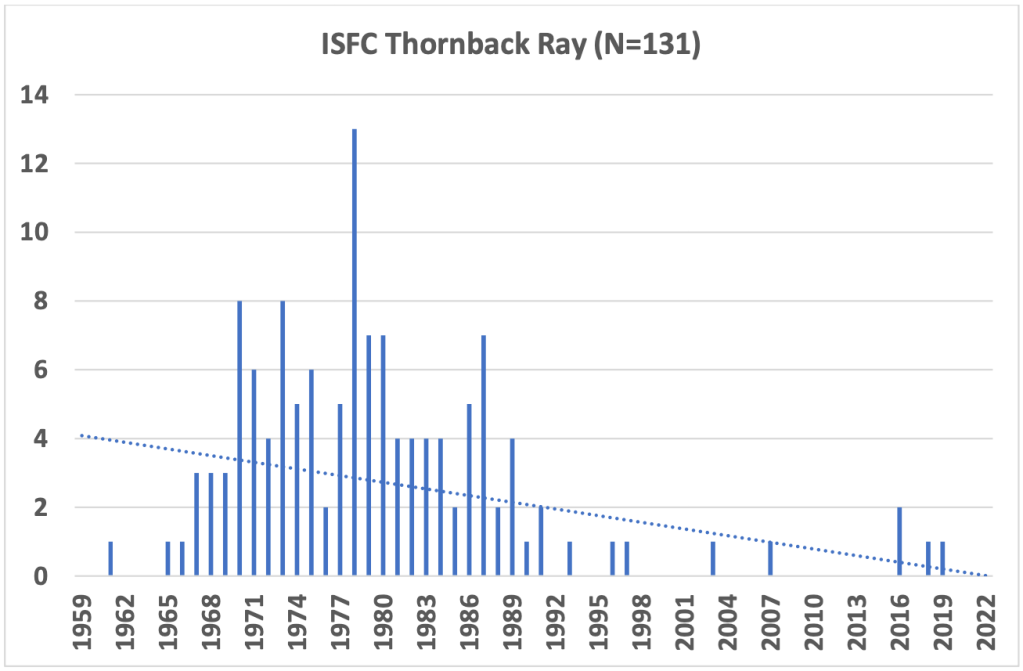
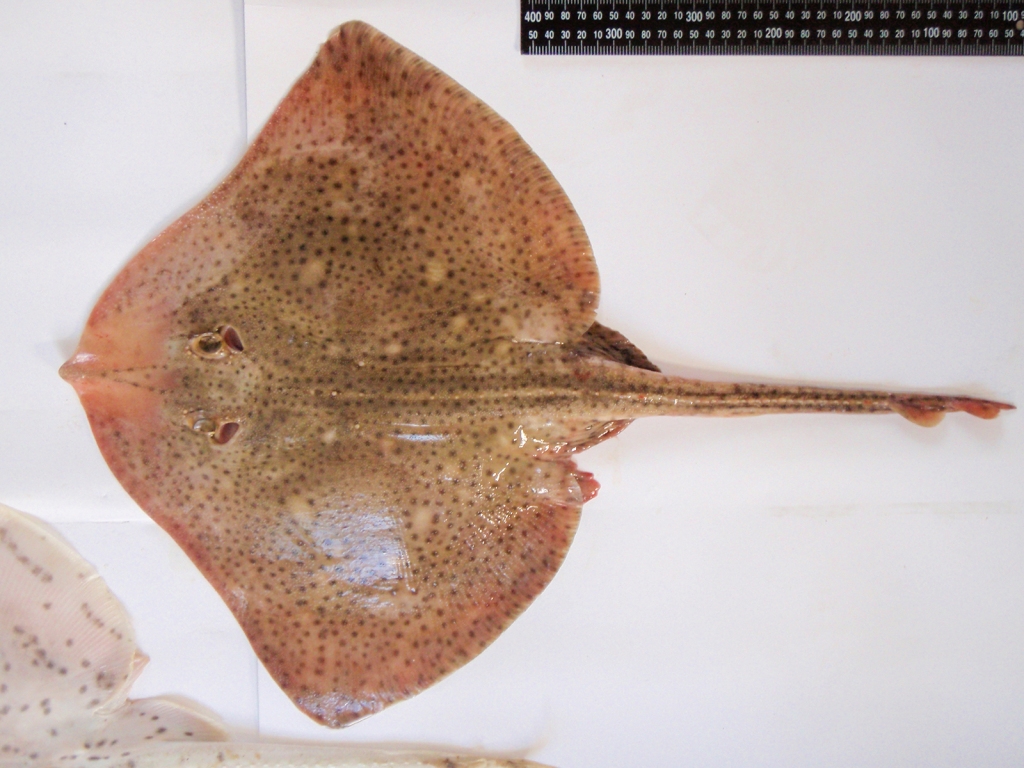

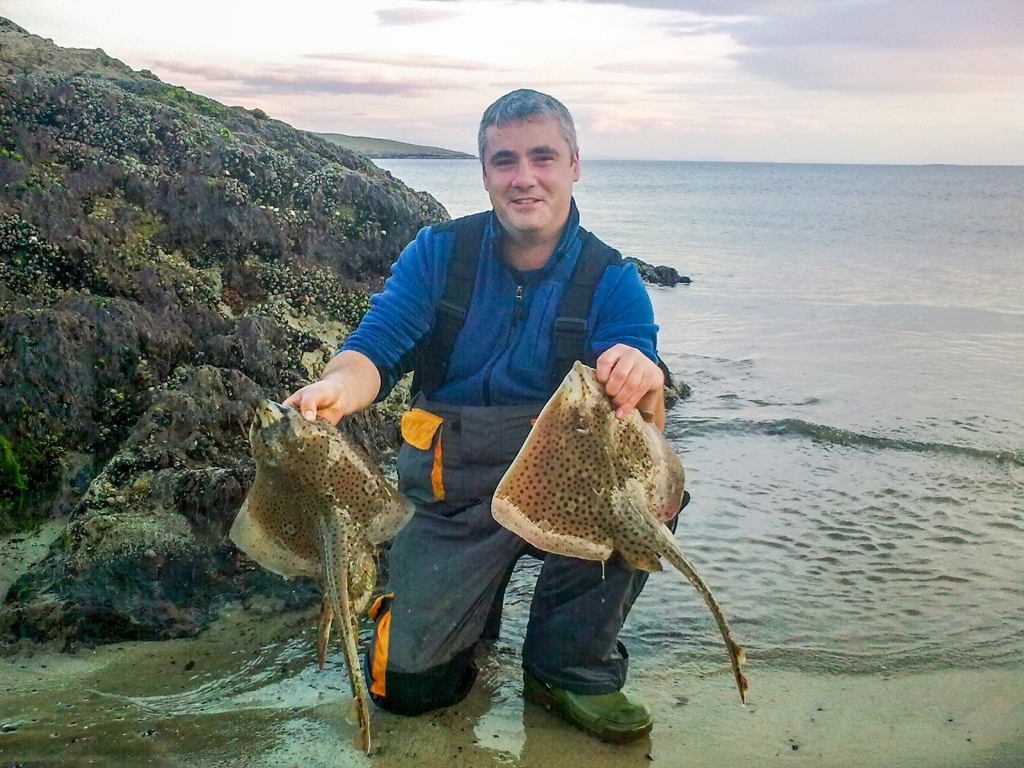
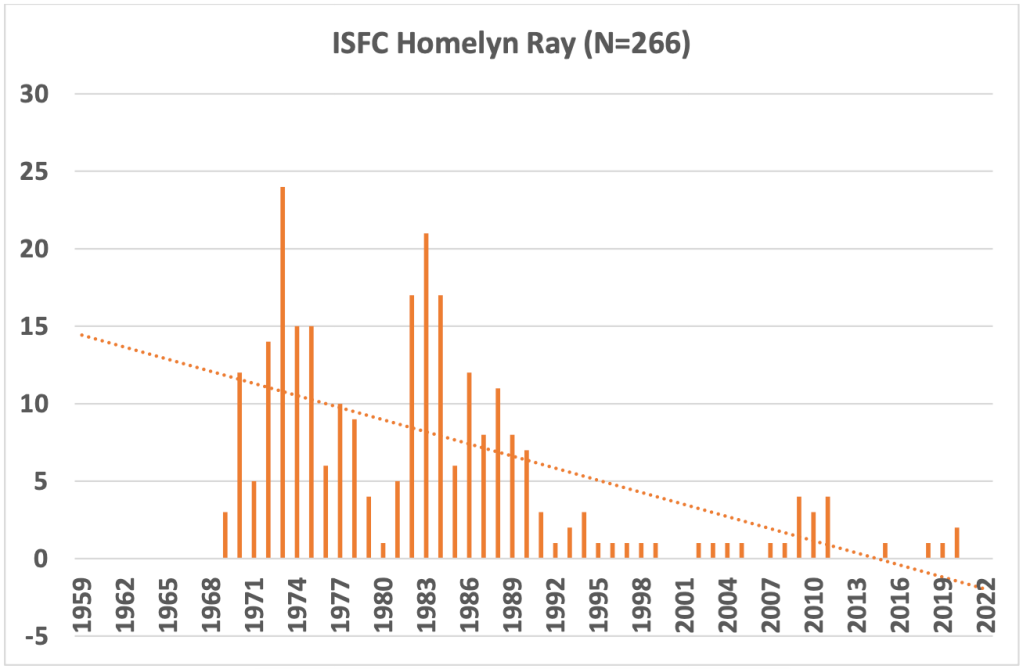
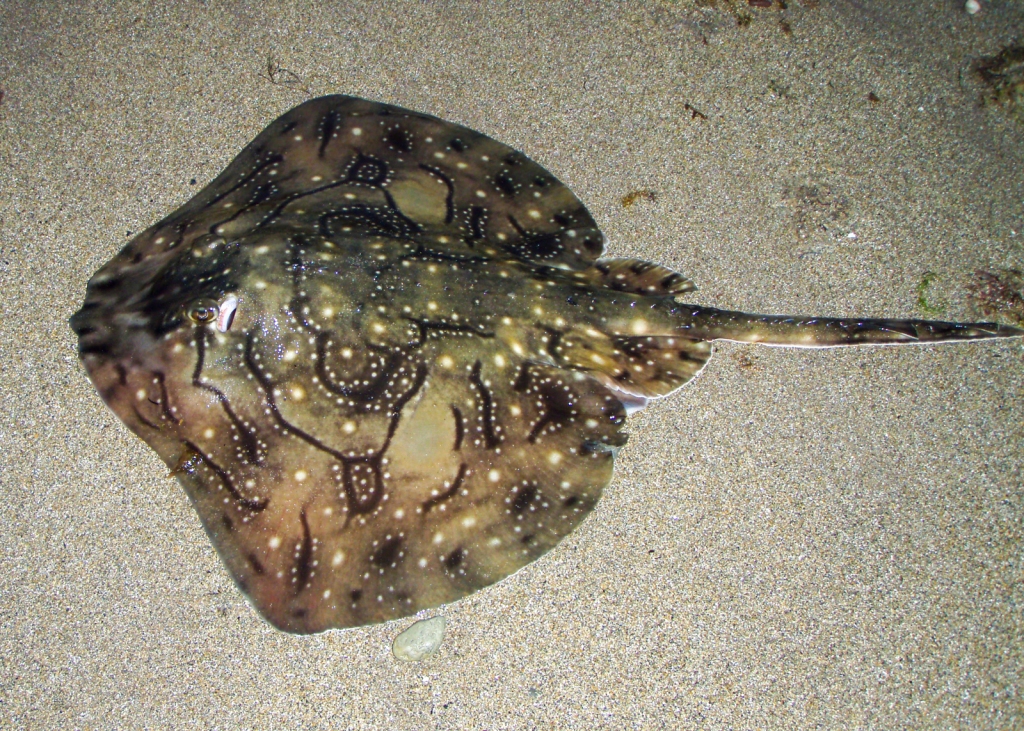
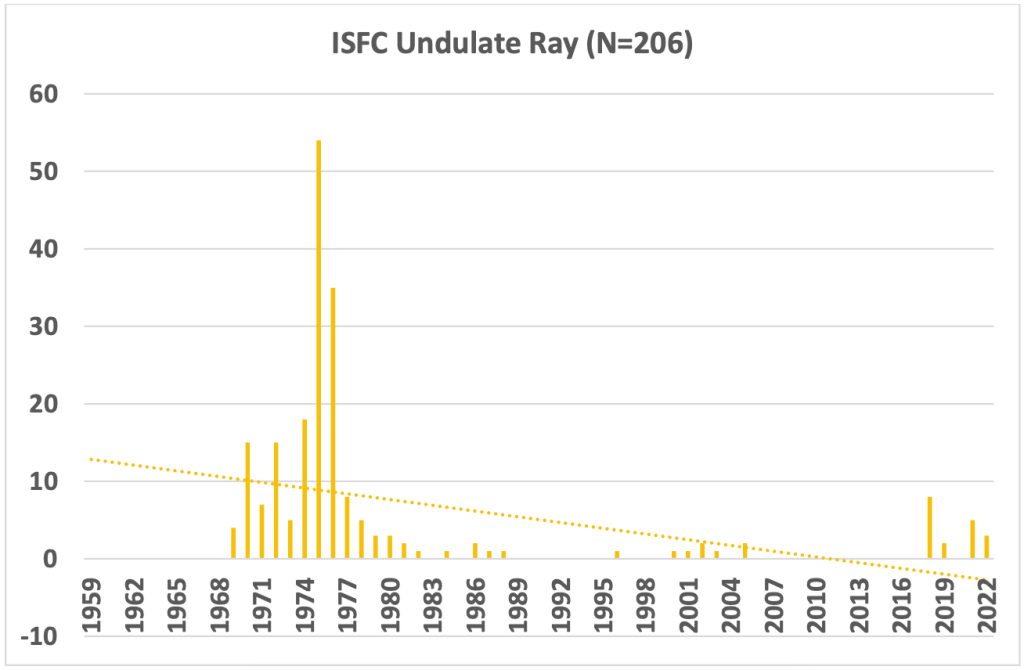
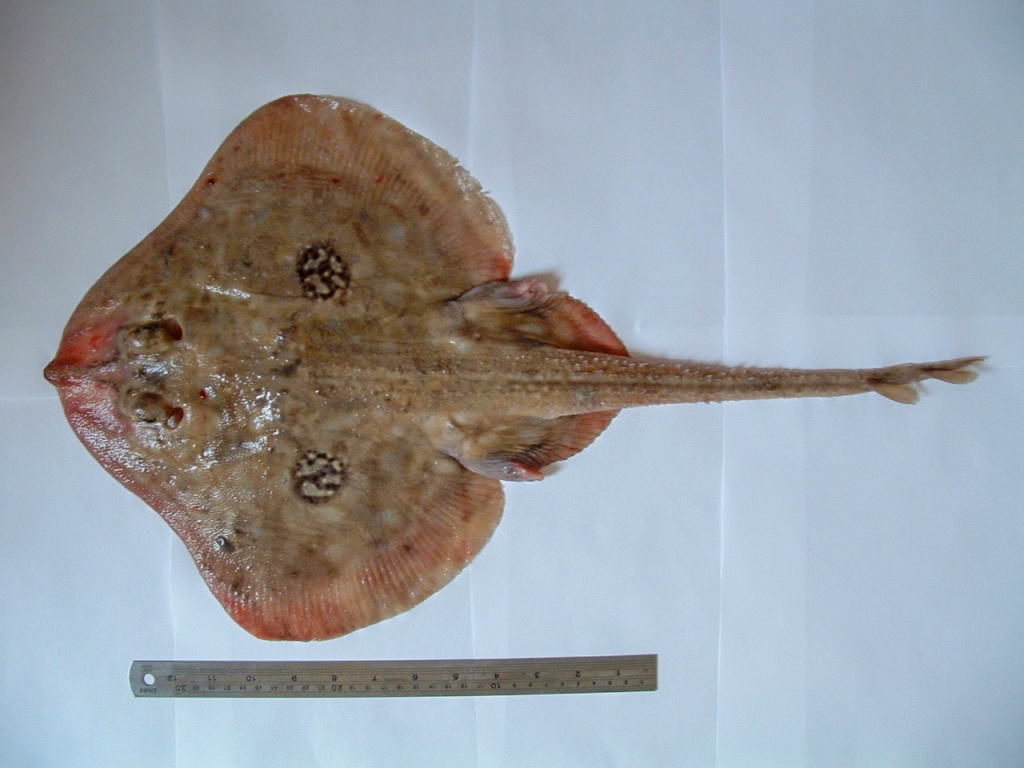
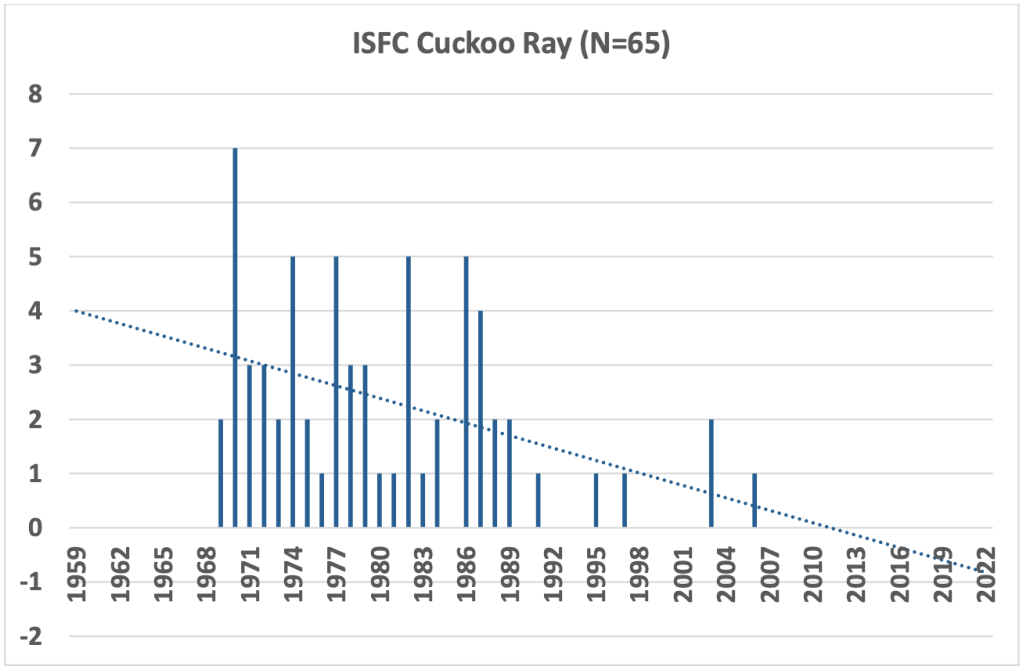
Annual Numbers of Shore-Caught Specimen Rays
Only three species of rays are commonly shore-caught: Undulate Ray, Painted Ray, and Sting Ray. Apart from Undulate Ray, which has demonstrated an appreciable downward trend, Painted Ray and Sting Ray have demonstrated a general upward trend.
It is important to consider that the Undulate Ray was removed from the ISFC list for over a decade (2006-16) due to concerns about its conservation status and restricted Irish distribution, particularly in Tralee Bay. Indeed, most of the specimen Sting Ray have also been recorded from Tralee Bay. Painted Ray also appear to be localised. Over 30% of the specimens were recorded from Youghal, Co Cork, 26% during 2014, but relatively few since then.
Commercial exploitation of Rays
Prior to 2009, commercially caught skates & rays were not distinguished to species level and were simply recorded as ‘Skates & Rays’.
Since 2009, all commercially caught skates & rays are required to be specifically logged by species, either as retained or discarded catch. However, it seems that there are still ongoing issues with species identification because the percentage of recorded commercial species does not always correlate with scientific survey data.
Summary and Conclusions
Based on the historical accounts and the current ISFC data that I have analysed, it is difficult to verify “that several decades ago, let’s say in the 50s or maybe 70s, it was a very rare occurrence for anglers to catch a ray off the beach”. During the 1940-80s, shore-caught rays were probably rarely reported rather than rarely captured.
Although the ISFC data indicates that some species of rod-caught ray (mostly interpreted as boat-caught) appear to have declined, some localised, presumably shore-caught species appear to have been increasing. However, there are many unknown factors that need to be considered in interpreting the data.
It is difficult to reliably correlate the potential effect of commercial exploitation on the rod-caught rays.
It is possible that the analysis of effort-related data from shore-based angling competitions may provide more robust data on the on-going status of shore-caught ray species.
References
Anon (1948) The Angler’s Guide to the Irish Free State. (4th Edition) Stationery Office, Dublin.
Brennan, D. (1965) The Sea Angler Afloat and Ashore. Adam & Charles Black, London.
Brennan (1974) Skates and Rays. Osprey Publishing Ltd., Reading, UK.
Davies, W.E. (1959) Footloose with a Fishing Rod – Places to Fish in Britain & Ireland. Elliot’s Right Way Books, Kingswood, Surrey.
Gammon, C. (1966) Salt Water Fishing in Ireland. Herbert Jenkins, London.
Kennedy, M. (1956) Salt-Water Angling. Hutchinson, London.
Warner, D., Linnane, K. & Brown, P.R. (1980) Fishing in Ireland – The Complete Guide. The Appletree Press Ltd., Belfast.
Went, A.E.J. (1956) Specimen Fish Records in Ireland. Salmon & Field (7): 23-25.
Whelan, K. (1989) The Angler in Ireland – Game, Coarse & Sea. Country House, Dublin.
Acknowledgements
Author of the original text: Declan Quigley
Photos courtesy of Declan Quigley, James Raymond aka The Best Angler in Ireland, and Ian O’Grady
The scanned historical photos acknowledged by source (Brennan 1965, 1974 & Gammon 1966)
Cover image: Clive Gammon lands a beach-caught ray during the early 1970s (Skates & Rays, Des Brennan, 1974)

Very nice read .
The Thornback , Blondes and Stingray data unfortunately hurts me. The specimen size for Thornbacks needs to be revised IMO. Its far too big a size. I have not heard anyone get a specimen Thornbacks from the shore in years but Thornbacks are so abundant. The Shannon is stuffed full of them and I would expect some big rays to come out of it but they just don’t so I wonder where those old specimen weights come from and how trust worthy are they? For the Stingray I think its the opposite.I think Stingray have become “fashionable” to catch at the moment and hence the upward trend of specimens but a 90cm Stingray is quite small. Whether it is low so that more data can be gathered for Stingray I’m not sure but it certainly is too small when you can go through Face book and see many rays over the 110cm mark but them not being recorded. I myself have three specimen ray this year but can only claim two due to the nose of the ray not being in the photo. The blonde ray is a killer. Almost all the specimens used to be caught on the Turbot bank in Cork harbour and then in 2010 , I think or might have been earlier looking at the data, a trawler came through the bank and destroyed the fishery. Haven’t seen many Blondes taken from there in the years so its made a significant impact effectively wiping out a strong hold.
– James
LikeLiked by 1 person
Thanks for your insightful comment, James. I agree on all points!
LikeLike